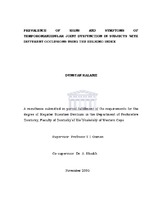| dc.contributor.advisor | Osman, Yusuf I. | |
| dc.contributor.advisor | Shaikh, A | |
| dc.contributor.author | Kalanzi, Dunstan | |
| dc.contributor.other | Dept. of Restorative Dentistry | |
| dc.contributor.other | Faculty of Dentistry | |
| dc.date.accessioned | 2013-05-23T10:38:37Z | |
| dc.date.available | 2007/03/12 10:09 | |
| dc.date.available | 2007/03/16 | |
| dc.date.available | 2013-05-23T10:38:37Z | |
| dc.date.issued | 2005 | |
| dc.identifier.uri | http://hdl.handle.net/11394/206 | |
| dc.description | Magister Scientiae Dentium - MSc(Dent) | en_US |
| dc.description.abstract | The controversy surrounding the role of malocclusion and orthodontic treatment in temporomandibular joint (TMJ) dysfunction led to this study. The purpose of this study was to establish the prevalence and compare the status of signs and symptoms of TMJ dysfunction in four groups of adolescents and young adults. The groups consisted of 14 persons with normal occlusions, 23 with untreated malocclusions, 20 with malocclusions currently undergoing treatment, and 18 with treated malocclusions. The Helkimo index was used to collect the TMJ dysfunction data. The results showed that the untreated malocclusion group had the most number of persons with signs and symptoms of dysfunction, but the differences between the groups in the distribution of persons according to the anamnestic and clinical dysfunction indices were not statistically significant. There were also no statistically significant differences in the distribution of signs and symptoms between boys and girls. According to anamnesis, the most frequently reported symptoms were joint sounds and headaches or neckaches occurring more than twice a week. Amongst the clinical signs and symptoms, the most commonly occurring were joint sounds on auscultation and muscle tenderness on palpation. In light of the small study sample and the absence of any substantial differences between the four groups, the role of malocclusion and orthodontic treatment in the aetiology of TMJ dysfunction remains obscure. | en_US |
| dc.language.iso | en | en_US |
| dc.publisher | University of the Western Cape | en_US |
| dc.subject | Malocclusion | en_US |
| dc.subject | Occlusion (Dentistry) | en_US |
| dc.subject | Orthodontics | en_US |
| dc.title | Prevalence of signs and symptoms of temporomandibular joint dysfunction in subjects with different occlusions using the Helkimo index | en_US |
| dc.type | Thesis | en_US |
| dc.rights.holder | University of the Western Cape | en_US |
| dc.description.country | South Africa | |

